11 Types of Hawks in Alabama (With Pictures)
Alabama is the perfect spot to find some magnificent-looking hawks. Some common species include the Broad-winged, Red-tailed, and Red-shouldered hawks. The Broad-winged hawk is more common during the summer, while the Red-tailed and Red-shouldered hawks are more prominent during the winter.
However, those are not the hawks that you spot in the state. In fact, there are a total of 11 different species of hawks in Alabama. And if you continue reading, you can learn about them.
Are There Hawks in Alabama?
You can spot a variety of hawks in Alabama. But among them, the one that is present throughout the state is the Red-shouldered hawk. If you have recently been near water bodies, such as swamps and rivers, you might have already heard their iconic whistle.
11 Types of Hawks in Alabama
Not all the 11 species of hawks are recognized in the checklist of Alabama. Three are considered to be rare or accidental. The rest eight are identified in the official checklist. With that said, let’s get to know about each of the hawks that you can spot in Alabama:
Red-tailed Hawk (Buteo jamaicensis)
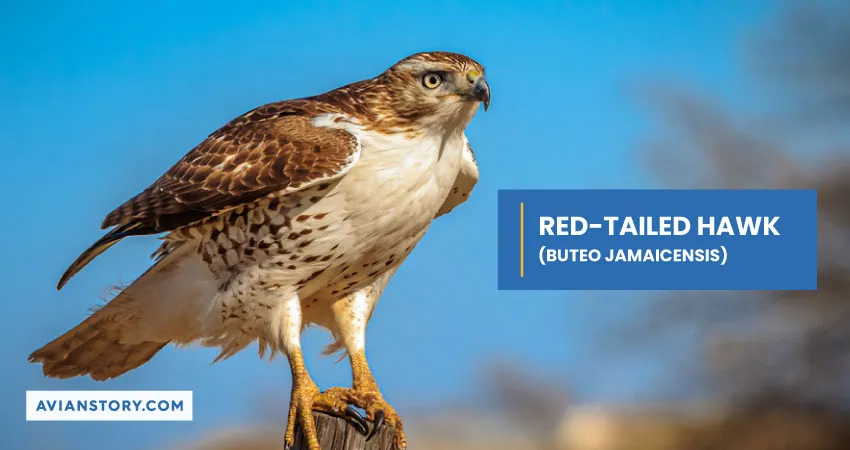
The Red-tailed hawks are most frequently spotted in Alabama during the winter. However, you can spot them during the summer as well.
Attributes
The name of these hawks really tells it all. They have red-colored tails that are short and wide. The tails are the most prominent standout feature of these raptors. But apart from that, you can identify these hawks by looking at their wings, which are large, broad, and rounded.
Additionally, they have pale underneath and brown in color on the back. Most of the adults have cinnamon-read feathers. But, most importantly, they have a distinct whistle. Their screams are high-pitched, raspy, and easily noticeable.
Diet
Red-tailed hawks mostly fly on top of open fields. They circle around and hunt down small mammals, reptiles, and small-sized birds. But do not be surprised when you find them feasting on medium-sized reptiles or large-sized birds.
Nesting Preference and Eggs
Anything tall is a perfect nesting spot for these birds of prey. Be it a manmade structure, such as tall towers or buildings, or natural, such as cliff ledges and tall trees; they will nest on the spot if it is tall enough.
Why so? They like to have a commanding view of their surroundings.
Regarding clutch size, females tend to lay 1 to 4 eggs. And to identify them, just remember that their eggs are whitish in color with brown spotting on the top.
Red-shouldered Hawk (Buteo lineatus)
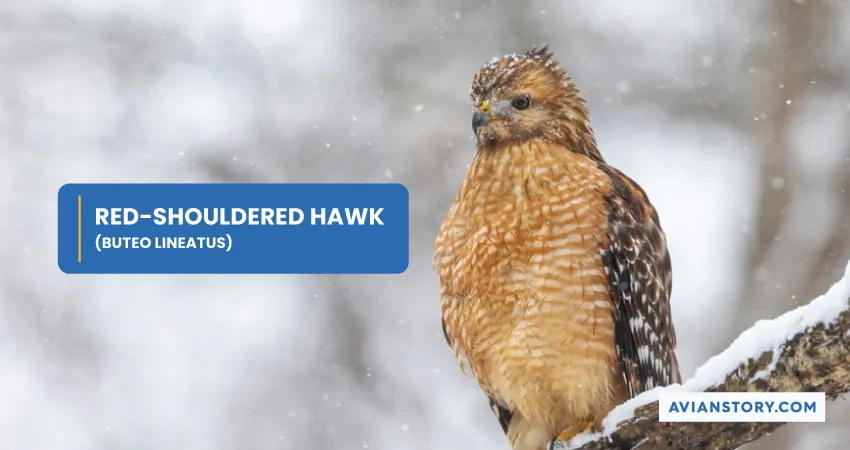
The Red-shouldered hawks have declined to a noticeable amount in Alabama. However, you can still spot them all around the year. But if you want to spot one of them, you should try it in winter. That is when they are most spotted around the state.
Attributes
Spotting red-shouldered hawks will be reasonably easy for you. They come with distinctive markings on their body. Their chest has a reddish barring, while their wings feature white and dark checkering. Also, when they fly, their wings appear rounded, which is another identifiable trait you should know about.
Other than that, they have medium-sized bodies. When they fly, their tails tend to fan out, while their wings tend to stretch forward. They are also known for having translucent crescents near their wingtips, making distinguishing them from other types of hawks easier.
Diet
Red-shouldered hawks are mostly found around water bodies, where they prey on small mammals and aquatic animals. You will mostly find them feasting on snakes or frogs. They also eat lizards.
Nesting Preferences
These tend to reuse their nests every year. And their preferred spot to nest is around water bodies, such as a stream or a river. That is where they can have easy access to their food source. In general, they pick a tall point of deciduous tree that is around a water source.
When it comes to clutch size, hawks can lay anywhere from 3 to 4 eggs. Their eggs are bluish-to-white in color.
Cooper’s Hawk (Accipiter Cooperii)
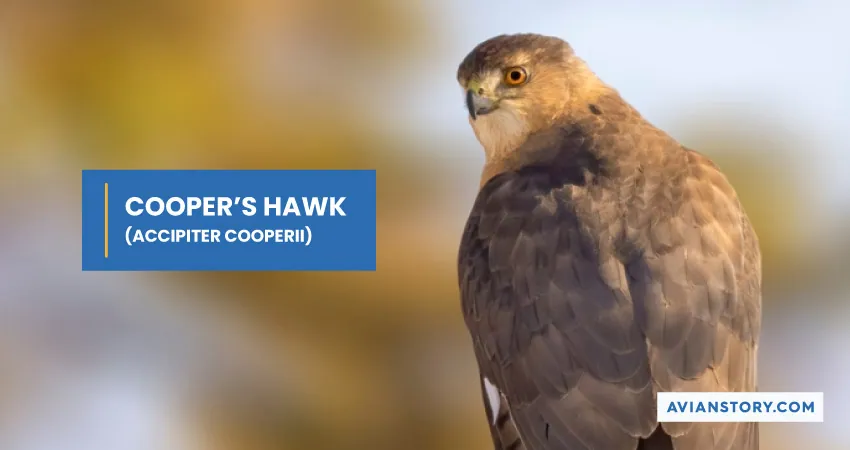
Another hawk that you can spot all around the year in Alabama is Cooper’s hawk. However, they are most commonly spotted during the winter. In summer, they tend to fly north.
Attributes
Cooper’s hawks may look similar to Sharp-shinned hawks, but they are larger in size. Most adults are close to the size of a crow. However, their size does not make them easier to identify them. They tend to have the same red-orange chest, dark bands on the tails, and blue-gray colored back as Sharp-shinned hawks.
So, if you want to spot these hawks, you need to focus on their heads when they are flying. When in flight, their head projects beyond their wings.
Diet
These raptors are mostly found around backyard bird feeders. There, they wait to snag an easy meal, small birds. Other than that, they also rely on small mammals and medium-sized birds.
Nesting Preference and Eggs
In terms of nesting spots, Cooper’s hawks prefer tall trees. They usually utilize old nests of large-sized birds. And if you happen to come across their nests in the breeding season, you can find 3 to 5 bluish-white eggs inside.
Northern Harrier (Circus cyaneus)
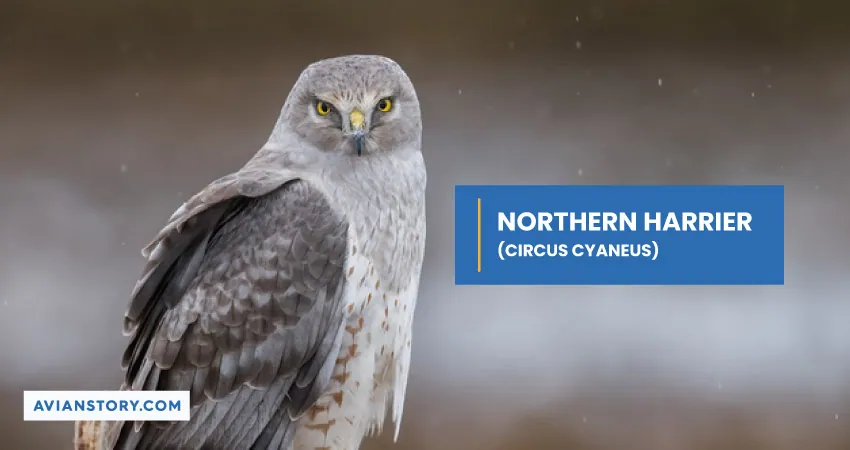
The Northern Harriers are not that common in Alabama. You have better chances to spot them only during winter. When summer starts, they fly north to their breeding grounds.
Attributes
Northern Harriers are known to have slender bodies and long broad wings. In terms of the size of their bodies, it is in between a goose and a crow. But the thing that makes them easy to identify is their flying style. They tend to fly by placing their wing tips higher than their bodies.
Alongside that, when they fly, they attain a V-shape. Regarding coloration, females have a brown body, while males have a white under part and a grey upper part. You will also notice a white rump patch on them.
Diet
The diet of Northern Harriers changes with the change of season. But it mostly consists of small birds and small mammals. You can also find them feasting on large-sized animals.
Nesting Preference and Eggs
One of the interesting facts about the Northern Harriers is that they nest on the ground. However, they do not just pick an open area for nesting. Instead, they prefer dense vegetation like willows, reeds, and bush trails. And during the breeding season, females can lay 4 to 9 eggs.
Broad-winged Hawk (Buteo platypterus)
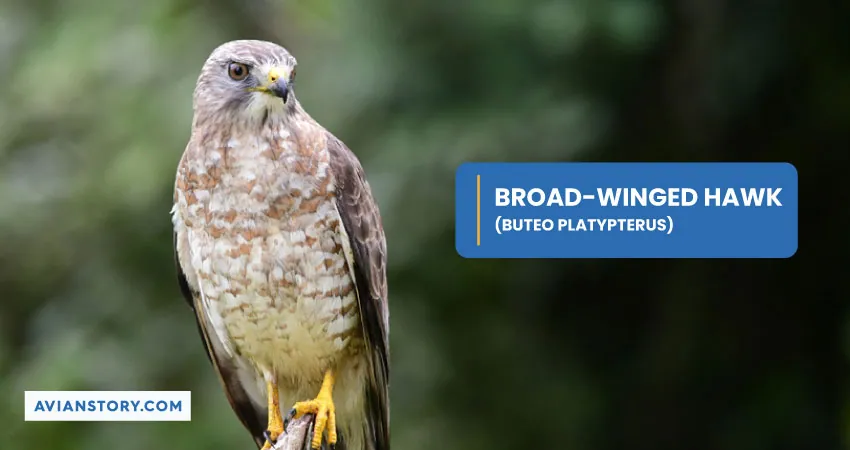
In Alabama, you can catch a glimpse of the Broad-winged hawks during their breeding season, which is summer. They are pretty rare, though. You have better chances of spotting the hawks mentioned above than the Broad-winged hawks in Alabama.
Attributes
Just like the name suggests, these raptors have broad wings. But that is not the only trait you need to know about them. These birds have compact and stocky bodies, which are between the size of a goose and a crow. Their heads are reddish in color, while their chests are barred.
Some of the adults might have reddish-brown plumage on their upper parts and heads, and their underparts will be pale in terms of color. It is easier to spot them while flying. They like to fly high and dive straight toward the ground while landing.
Diet
The diet of the Broad-winged hawks is pretty diverse. But they generally rely on frogs, young turtles, snakes, and small mammals. For hunting, their preferred spots are near woods and the edges of water bodies.
Nesting Preference and Eggs
Broad-winged hawks mostly reuse the nests of other animals. So, do not be surprised to see them laying eggs in an old squirrel home. On the note of eggs, females can lay 1 to 5 whitish eggs. In most cases, their eggs have some brown spotting on the surface.
Sharp-shinned Hawk (Accipiter striatus)
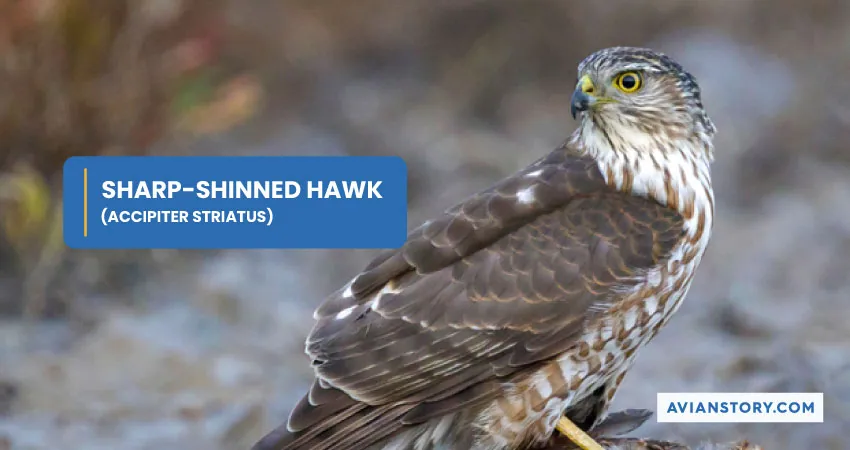
Another rare type of hawk you can spot in the skies of Alabama is the Sharp-shinned hawk. You will have better luck catching them during the winter. They are mostly spotted around Montgomery and Birmingham. Also, you should know that only the non-breeding population is available in Alabama.
Attributes
Setting Sharp-shinned hawks and Cooper’s hawks apart is pretty challenging. Even expert birdwatchers find it difficult. Both raptors have blue-gray coloration on their bodies and redding streaking in their underparts.
And just like Cooper’s hawks, Sharpies have short and rounded wings.Besides that, they have long tails and lanky legs.
So, how can you tell them apart? Their body size! Sharpies tend to be smaller than Cooper’s hawks.
Diet
The diet of Sharp-shinned hawks is mostly songbirds. In fact, 90 percent of their diet consists of those birds. That is why you will find them around bird feeders found in backyards. Aside from songbirds, they feed on rodents, lizards, bats, squirrels, snakes, frogs, and large insects.
Nesting Preference and Eggs
Sharp-shinned hawks are known to be very secretive, which is it is pretty challenging to spot their nests in the wild. But, in most cases, they will nest in conifer trees with dense cover. And their preferred spot to nest is on the tallest point of the trees.
During the breeding season, their nest can be full of eggs. These hawks can lay anywhere from 4 to 5 eggs that are blue-white in terms of color. Their eggs also have brown markings on the surface.
Swainson’s Hawk (Buteo swainsoni)

The Swainson’s hawks are not that easy to spot in Alabama. And throughout time, they have been only sighted near the southern part of the state, along the coast. You should also note that there is a high chance of catching them in Alabama during May and September when they set out for a long migration.
Attributes
One of the most identifying traits of the Swainson’s hawks is their tails and wingtips. They have pointed wingtips and short tails, which are highly noticeable while they are flying.
Also, when they are flying, it is easy to see the contrast in their flight feathers. The contrast is between the lower edges of their black feathered tips and wings and the white upper part of their wings.
In terms of the coloration of their bodies, they have gray or brown mottled on the back. Their chests are brown or red in color, while their bellies tend to be lighter.
Diet
The diet of Swainson’s hawks depends on what is abundantly available in their areas. For example, when Burrowing Owls are abundant in the area, they will hunt them and primarily rely on them as a food source. Basically, they are not fussy and can eat anything. That includes crickets, dragonflies, rabbits, mice, and bats.
Nesting Preference and Eggs
You will not find many nests of these hawks in the open country. They mostly use trees that are near low mesquite bushes or fields, tall power poles, and high buildings. Their nests are mostly of grasses and twigs. And females are known to lay 2 to 4 white eggs.
Rough-legged Hawk (Buteo lagopus)
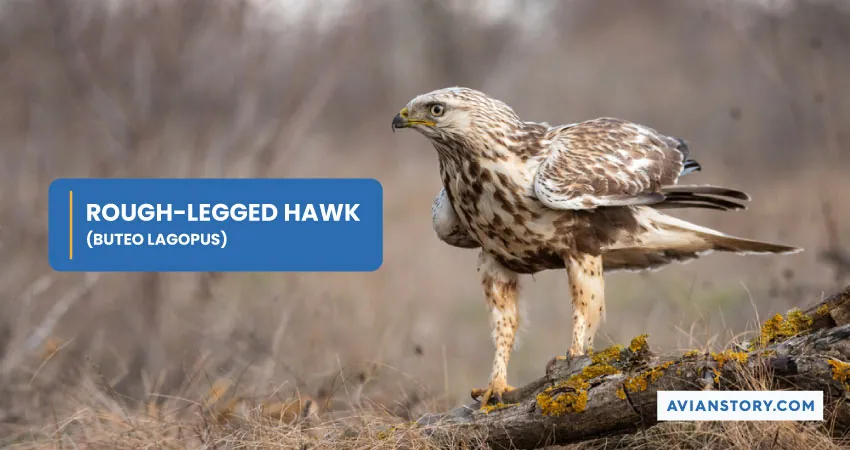
Although Rough-legged hawks are not that common in Alabama, you can still spot them in the winter season. And you will have a better chance of sighting them in the northern side of the state.
Attributes
Rough-legged hawks earned their name for having feathers all the way down to their toes. This is a standout feature, which helps them to stay warm in cold environments. Other than that, these hawks are usually larger in size. In terms of colors, they predominantly have dark-brown coloration.
Additionally, most are spotted with dark patches at the end of their tails, across their bellies, and at the bend of their wings. They have broad wings, which are relatively narrower and longer than other hawks.
Diet
Voles and lemmings are the primary food sources of these hawks. But if these two are unavailable, Rough-legged hawks rely on ground squirrels, mice, small rodents, and other small mammals.
Nesting Preference and Eggs
Treeless tundra, uplands, cliffs, boreal forests, and alpine regions are preferred spots for nesting. And bird watchers have spotted 3 to 5 bluish eggs inside their nests during the breeding seasons.
Northern Goshawk (Accipiter gentilis)
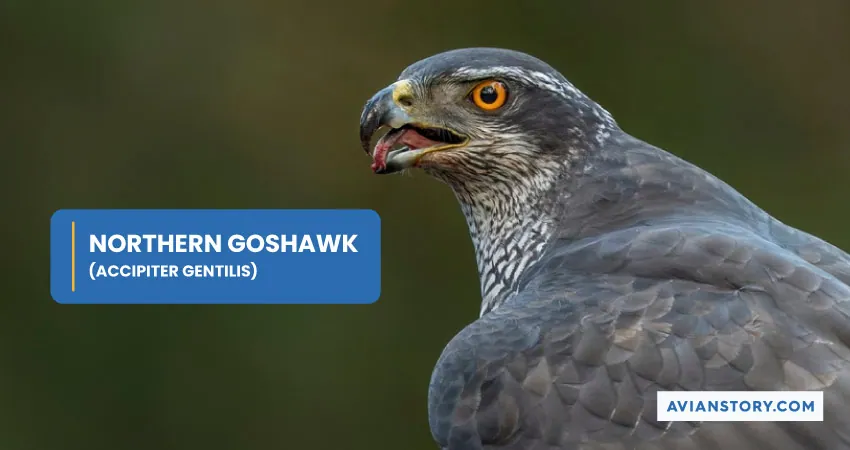
Alabama considers Northern Goshawks as accidental species. In simpler words, these hawks are extremely hard to spot in the state.
Attributes
Compared to Cooper’s and Sharp-shined hawks, Norther Goshawks are bigger and fiercer. Most of them are sighted with gray, short, and broad wings. Their tails are larger in size, and they have a white stripe over their eyes.
Diet
Northern Goshawks are seen eating different animals. They are highly adaptive and will rely on whatever is available in the area. But if you want to be specific, they mostly feed on mammals, insects, reptiles, and other birds.
Nesting Preference and Eggs
Like Sharp-shinned hawks, Northern Goshawks are highly secretive. Therefore, it is not easy to spot their nests. But according to records, they pick high points of large forests for nesting. Females can lay 2 to 4 eggs, which are blue in color and pretty large in size.
Ferruginous Hawk (Buteo regalis)
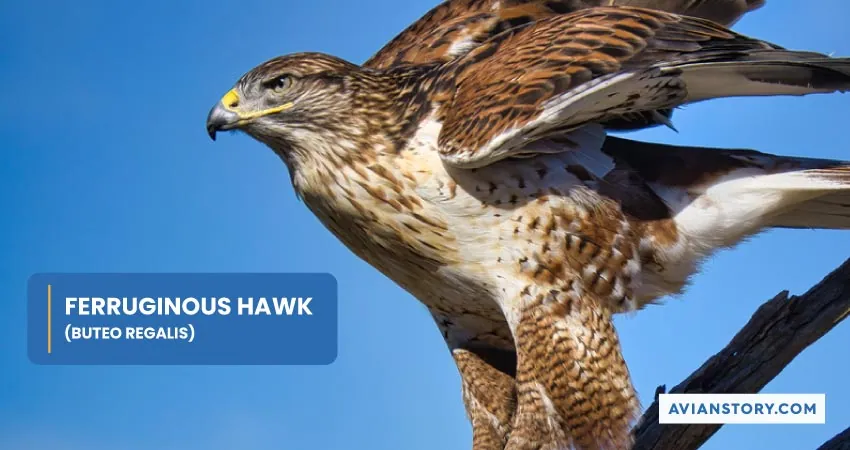
Another accidental species of Alabama is the Ferruginous hawk. They are not spotted that frequently. So, you should not keep a high hope of catching them flying the skies of the state.
Attributes
According to data from bird watchers, these hawks have long wings and large heads. But it is not easy to identify them. The coloration of their bodies varies largely. They come in dark and light morphs, which can have different patterns.
Nonetheless, the thing that is consistent among all the Ferringinous hawks is the rusty-colored legs and shoulders. This coloration is the reason behind the name of these hawks.
Other than that, the coloration has noticeable contrasts with the underparts, which are generally bright white.
Diet
The diet of these birds depends on what is available. They are not picky, but a huge portion of their diet consists of small mammals. You can even find them munching on cottontail rabbits, jackrabbits, and squirrels.
Nest Preference and Eggs
Ferruginous hawks prefer large trees, shrubs, and low cliffs for nests. They have a tendency to live in large-sized nests, which can be 3 feet wide and 3 feet deep. And when it is breeding season, the females can lay 1 to 8 bluish-white eggs. Yes, their nests can get quite populated.
Short-tailed Hawk (Buteo brachyurus)
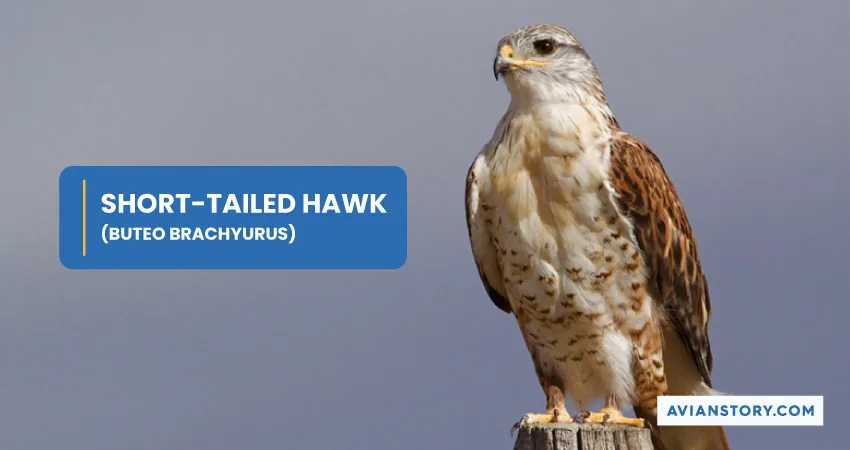
These birds of prey are also considered to be accidental in Alabama. They are exceptionally rare in the state.
Attributes
As the name suggests, Short-tailed has shorter tails than most of the other hawks. They are sighted with both dark and light coloration. The dark morphs tend to have dark brown colorations and lighter flight feathers. On the other hand, light morphs have white below and brown feathers on their back.
Diet
The diet of Short-tailed birds mostly has small-sized birds. Occasionally, they will feast on lizards, tree frogs, insects, rodents, and snakes.
Nesting Preference and Eggs
Nests of Short-tailed hawks can be found on top of trees. They prefer spots that are 30 to 60 feet high from the ground. The clutch size of these birds is 2 eggs, which are pale bluish-white in color. Sometimes, their eggs can have reddish-brown spots.
| Name | Length | Weight | Wingspan | Commonly Found In | Behavior | Fun Fact |
| Red-tailed Hawk | 17.7 to 25.6 inches | 1.52 to 3.22 pounds | 44.9 to 52.4 inches | Perched along the edges of roads where there are many trees around. | Territorial | Ever since the 1980s, the population of Red-tailed hawks in North America has increased by 33 percent. |
| Red-shouldered Hawk | 16.9 to 24.0 inches | 1.07 to 1.71 pounds | 37.0 to 43.7 inches | Around mixed and deciduous forests. Also, near water bodies, such as swamps and rivers. | Solitary and very territorial | While in flight, Red-shouldered hawks give a short series of whistles, which are slurred together. |
| Cooper’s Hawk | 14.6 to 17.7 inches | 0.49 to 1.5 pounds | 24.4 to 35.4 inches | Open woodlands and mature forests. | Territorial and aggressive | Cooper’s hawks have a pretty unusual flight pattern. They tend to beat their wings several times and then glide away. |
| Northern Harrier | 16.14 to 19.68 inches | 0.69 to 1.69 pounds | 41 to 46 inches | Open areas, such as marshes, prairies, fields, and grasslands. | Primarily solitary | Northern Harriers are the only type of harrier found in North America. |
| Broad-winged Hawk | 13.4 to 17.3 inches | 0.58 to 1.24 pounds | 31.9 to 39.4 inches | Mixed deciduous and dense deciduous forests. | Mostly territorial but stay solitary when they are not migrating. | Broad-winged hawks get their names for having short and broad wings. |
| Sharp-shinned Hawk | 9.4 to 13.4 inches | 0.19 to 0.48 pounds | 16.9 to 22.1 inches | Around backyard feeders and in densely woodend regions. | Solitary but becomes highly territorial while breeding. | Sharp-shined hawks get their name for having thin and exposed lower legs. |
| Swainson’s Hawk | 18.9 to 22.1 inches | 1.53 to 3.01 pounds | 46 to 54 inches | Over the Great Plains and in open country on the West side. | Highly territorial during the breeding season | Swainson’s hawks are famous for being the longest migrants. |
| Rough-legged Hawk | 18.5 to 20.5 inches | 1.58 to 3.09 pounds | 52.0 to 54.3 inches | Around nestles of tundra and cliffs of low-lying boreal forests | Territorial | The Rough-legged hawks are among the three species of American raptors who have feathers all the way to their toes. |
| Northern Goshawk Hawks | 20.9 to 25.2 inches | 1.40 to 3.01 pounds | 40.5 to 46.1 inches | Mixed forests or coniferous forests. | Highly territorial | These species get their name from The old English word “goose hawk.” |
| Ferruginous Hawk | 20 to 25 inches | 2 to 5 pounds | 52 to 56 inches | In the open country of the west, in shrublands and grasslands of the low country. | Solitary | Ferruginous hawks are considered to be the largest hawks in North America. |
| Short-tailed Hawk | 15 to 17 inches | 0.8 to 1.1 pounds | 32.7 to 40.6 inches | Mountainous plains, moist areas, and tropical regions. | Solitary | Short-tailed hawks are specialists when it comes to hunting birds. They can catch both large-sized and extremely small-sized birds. |
Conclusion
So, in total, you can spot 11 different hawks in Alabama. But do not expect to catch a sight of all, as only 8 of the species are officially recognized. The other three are extremely rare or accidental: Northern Goshawks, Ferruginous, and Short-tailed hawks.
Relevant Resouces:
- https://www.hawkmountain.org/raptors/coopers-hawk
- https://www.allaboutbirds.org/guide/Broad-winged_Hawk/lifehistory#
- https://www.audubon.org/field-guide/bird/sharp-shinned-hawk
- https://www.peregrinefund.org/explore-raptors-species/hawks/ferruginous-hawk
